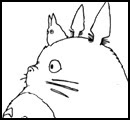"Up" is Pixar's "The Emperor's New Groove." This may sound like a dismissal, but I really like "The Emperor's New Groove." It's a loopy, inventive lark, free from ponderous expectations of being the latest "important" Disney film.
"Up" is a similarly freewheeling adventure. With a few dozen bushels of helium balloons, Carl Fredricksen (voiced by Ed Asner, whose full name appears in crosswords more than you'd think) steers his airborne house to the Amazon Basin. Russell, a very round and earnest kid, accidentally stows away on the flight. "Up" has a lot of fun with the setup and with what Carl and Russell find when they arrive.
Initially, the meet a Rain-Blo-colored female bird that Russell names Kevin. Kevin has the temperament of a few different kinds of birds--ostrich, flamingo, chicken, turkey--combined with the physical genius of Donald O'Connor. She's an utterly original creation. Kevin and Dug, a talking dog, get the biggest reaction from the audience.
An ostensibly tear-jerking preface opens "Up" in the wrong direction. Carl's mostly silent life-story is a carbon-copy of similar, more effective sequences in earlier Pixar movies. I'm thinking of Jessie's abandonment in "Toy Story 2," the look back at Radiator Springs's heyday in "Cars," and even the first two acts of "Wall•E." Carl's old age, so forcefully introduced, is regularly contradicted: he can't walk down stairs, but he can hike over a mountain for days while dragging a floating house? Maybe writer-director Pete Docter feels a Pixar movie can't be simply fun. The brand demands pathos, no matter how corny.
In trash like "My Bloody Valentine," 3-D is an excuse to thrust stuff at the audience as often as possible. Pixar has wisely made a solid movie first and then thought about 3-D. Pete Docter, the director of "Up," says, "We’re showing you a story, and the 3D should be in support of that, not the opposite."
After the initial excitement, the 3-D in "Up" is forgotten. During the film, I kept pushing my Carl Fredricksen-style 3-D glasses down in order to see the actual film. Through the glasses, it's as if "Up" has been projected through a glass of rainwater. It's a tragedy for a film this vibrantly illustrated. Of course, I had to make do with the glasses; watching without them may be brighter, but it's also blurrier.
Shocking 3-D is annoying and subtle 3-D is unnoticeable. Conclusion? 3-D is a joke. It's not the future of movies. Here's hoping the fad dies out faster than Hollywood thinks it will.















































